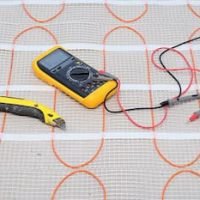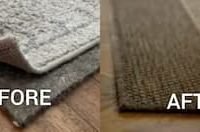Underfloor heating also known as radiant floor heating, is having a system installed beneath your flooring. The system is for a warmer environment on your carpet or floor. The installation is quite expensive but worth every coin you spend as it is energy efficient. It means the system is closed and there aren’t any ducts on the flooring to leak air, therefore, wasting energy.
It can be put in both new and already built houses and on any type of flooring, be it hard flooring or carpet. It’s only that in the old house it will cost you more for the renovation.
Rugs aren’t suitable for the underlay, but people are used to carpets
Below is a guide including ideas for selecting the best rug products.
There are two types of underfloor heating;
1. Electric underfloor heating system-
The heat is transferred with electric cables thin enough to be installed under wood floors, tiles, vinyl, stone, or laminate floors.
A thermostat controls the underfloor heating system.
The cables are, of course, heat resistant doesn’t have to worry about electric shocks and explosives.
2. Water underfloor heating-
Hydronic systems are attached to running hot water pipes. The pipes, just like the electric ones, can be placed under your flooring surfaces.
The underlay has a thermostat used to regulate the room temperature or set up a timer- on in the evenings only.
There are mobile apps today that can help you control the underfloor heating at your comfort.
You can check it out.
Advantages of underfloor heating
It is best at reducing carbon emission thus environmentally friendly.
The cold buster completely warms your feet during the cold days making it suitable in the bathroom, which is always dumped.
Underfloor heating Heats a large floor area- as opposed to heaters concentrated in a room, heat flows upward to the central heating point then spreads outward to other parts you want to be heated.
It distributes heat evenly and consistently on the flooring from the bottom to the top. The heat cannot warm a specific spot and leave out others. The whole floor gets covered as the temperature set is equal in every part.
The heating is energy efficient as it can still keep the heat levels up the room for a long time even after switching off the mortar. The temperatures are at standard degrees depending on the flooring types.
Your beautiful home decor doesn’t spoil as the wires get hidden under your floor plus no snagging on the carpets.
The underlays sometimes act as an insecticide as it helps keep crawling insects off the carpet because of the warmth.
Plus, the underfloor system does not produce noise, making it suitable in the bedroom since you don’t get disturbance in your sleep.
Carpets And Underfloor Heating
Carpeting a heated floor is quite challenging because of the heat effect, but we still want to try. You may ask yourself if the rugs work well with underfloor heating.
Yes, rugs are suitable With the underfloor heating systems. The heating, however, can cause damage to the carpet. You have to own well-suited rugs for use in radiant heating.
The coverings always add sensation to the house that you can’t do without them, and that is why you’re here trying to find the best fit to your solution suitable for underfloor heating.
There are different rugs in the market best for use with underfloor heating.
Things to consider before you stock your favorite carpets are whether the material can withstand high temperatures as the temperature on the floor is higher than usual. Some carpets get damaged because of the excess heat produced underneath.
Engineered wood has a maximum temperature limit. Adding a carpet will mean crossing the temperature limit causing damage.
You will need to choose rugs with the right thickness and materials to prevent damages.
Tips on How to choose the best carpets suitable for underfloor heating
Thickness- thick rugs retain heat and so deprive you of the warmth you desire. Shop for thin rugs that can pass heat from the floor to your feet.
Rugs material- synthetic fiber rugs do not hold or transfer heat. They may be damaged if exposed to too many temperatures and fail to hold onto the high temperatures anymore.
Natural fiber mats are more resistant to heat and more suitable for use with underlay heating. The rugs are best when used with engineered flooring as they can manage the excess underlay heating.
An example is wool rugs, sisal, jute, and silk rugs having a high thermal tog, which works best with floor heating due to their insulating element.
Never use the plastic collection as rugs unless you want to test the fire. They are prone to sliding, dents, and scuffs.
Underlay material- the rug backing should be best to use with your floor heating underlay. Plastic and synthetic rug pad are not good conductors of heat. They are going to melt if placed on top of a heated floor. The felt pads are not best for underfloor heating. Hessian carpet is a good choice recommended for underfloor heating. Carpet backed with rubber is another best carpet to use.
A good underlay also prevents slips due to their anti-slip nature.
Size- before buying a carpet, you should consider the floor surface you want to be covered. The bigger the carpets means that the large surface of the floor gets covered and so insulate heat on the floor ending up causing damage.
NOTE:-The carpets must never fit the wall to allow insulation.
Conclusion
Underfloor heating is the perfect option if you are looking for something ideal for heating your space, though expensive to install than radiators. It takes a while to warm your home, but when it does, it feels magical.
Please put better rugs on the floor if you have to use one.
Remember to buy an air conditioner since the radiant heater is not suitable for heating and cooling. When the weather gets hot, the AC comes in handy.
Reference
Updated on 2022-10-02 / This Article may have Affiliate links / Images from Amazon Product Advertising API
Contents





![Best Vinyl Floor Scratch Remover [ Honest Review] Best Vinyl Floor Scratch Remover](https://cutefloor.com/wp-content/uploads/2022/02/Best-Vinyl-Floor-Scratch-Remover-1-200x200.jpg)
![Is Swiffer Wet Jet Worth It? [Personal Experience, Honest Review] Is Swiffer Wet Jet Worth It](https://cutefloor.com/wp-content/uploads/2022/03/Is-Swiffer-Wet-Jet-Worth-It-200x200.jpg)


